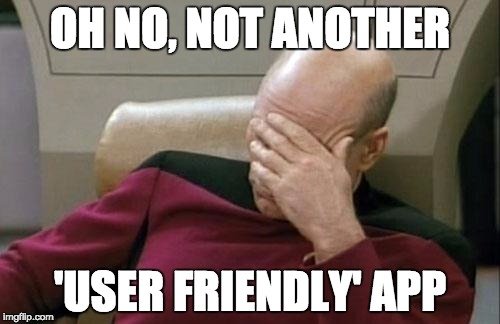Learn how to write website content for persuasion and customer centricity. This means that you need to spice it up with data, proof, and examples so that your website converts more visitors to inquiries and, finally, sales.
But What Does 'Persuasion' Mean?
People think that "being persuasive" means figuring out which secret magic words to put on their websites so that visitors are mesmerized into buying.
That's why content on business websites is riddled with words such as these:
- magnetic
- explode your profits
- cutting edge technology
- top of the notch
- best buy
- high-quality solution
- easy to use
- user friendly
- intuitive
If placed outside of context, these words sound hollow and boring. Some are even an insult to human intelligence.
I can almost hear website visitors say:

Oh no, not yet another 'user friendly' application! I'm sick of companies claiming that without explaining it. I'm out of here.
Persuasive writing is none of the above words. Persuasion is not about any word in particular. There’s no magic, either: there’s only years of writing experience and hard work.
Everyone can say that their product or service is easy to use.
In fact, because every can say that, everyone does say that. It's easy to say that something is easy to use, but it's much more difficult to explain it with words that answer customers' questions.
And that's what persuasion means to me: answering customers' questions.
If you feel like your product descriptions online are falling on deaf ears, it could be due to lack of persuasiveness of your claims. You're simply not answering customers' questions.
How Anyone Can Make Any Claim More Persuasive
Claims and thougths are easy, as long as they exist in our heads, or come out through our mouths. But, when you want to commit your thoughts to paper, writing gets hard.
Why is that?
It’s because we (incorrectly) believe that how we write website content must greatly differ from how we speak. We believe our spoken words aren’t fancy enough to appear on our business website. We believe that our customers want us to sound all business-y.
So, in our attempt to make our writing more business-y, all our common sense abandons us, and we end up annoying our customers.
Luckily, there are three elements of persuasion that can save you from sounding like a corporate B.S. generator:
- Data
- Proof
- Examples
You're already successful in persuading others with data, proof, and examples in your everyday communication.
Let's now see how you can use those on your B2B website.
Data
 Image source: https://www.pinterest.com/sameans3/star-trek/
Image source: https://www.pinterest.com/sameans3/star-trek/
(No, not that Data. Data as in numbers and stuff.)
Let's say that your company is selling business software to small companies.
When trying to explain a feature, most software websites claim something in the line of this:
Our printing feature is very fast.
Now, for every sentence you publish on your website, imagine every website visitor form the following question in their mind:
Oh really, very fast printing? What does that mean, exactly?
More specifically, imagine your visitors ask the following:
How fast, exactly?
If a customer asked your (good) sales reps the same question, they would not hesitate to answer that question directly:
Printing happens within seconds, because it only takes 1 click to send the document from the app to the printer.
See how, instead of "very fast printing", we used "within seconds” and "1 click”?
That’s how you use data to improve clarity of your content. Clear content is persuasive content.
Notice how using actual numbers and familiar units of measurement improves your marketing message:
- Everyone is familiar with clicking something on the screen one time. In fact, clicking something just once is so fast that you don't even need to try too hard to emphasize the word fast on your website page.
- A second is a globally understood unit of measurement. Everyone knows how long "printing within seconds" takes, and everyone can compare that to how long printing in their current software takes.
- You're gradually immersing your readers into the experience of using your software in their workplace. You're creating vivid images and lively movies for your readers to play in their heads. You're helping them see their printers, effortlessly spitting out sheets and sheets of paper.
- You’re making your product unique and different. Why? Because, when you've made a habit of using data throughout your website copy, no other product in the world can contain those exact specifications.
Proof
 Image source: http://ravepad.com/page/backdoor/images/view/11485600/John-Kenneth-Muir-s-Reflections-on-Cult-Movies-and-Classic-TV-Cu
Image source: http://ravepad.com/page/backdoor/images/view/11485600/John-Kenneth-Muir-s-Reflections-on-Cult-Movies-and-Classic-TV-Cu
Now that you've made your website content more specific with data and numbers, let's prove your claims. We're going to apply a writing technique favorite among world’s best novelists:
Show, don't just tell.
How could you show that it only takes 1 click to print out a document in your business software?
Gee, I don't know, how about doing this:
- Take screenshots in your application and publish them on your website. How hard can that be?
- Record a short, 10-second video and embed it into your website pages. Videos are great because they prove without a doubt that it really, truly takes only one click to print out a document.
- Let your visitors sign up for a free demo trial online. Just the fact that you have an online demo is proof enough that you don't have anything to hide, that you want your visitors to see it for themselves.
- Let your visitors request a personal guided demo in which your specialist could walk them through the product, showing them how the software works.
Examples
Examples can be like tiny stories, compressed to the length of a tweet or a paragraph.
It sounds simple, but it’s obviously not so easy: examples are the most neglected element of persuasion. Every writer, amateur or pro, has at one time been guilty of writing a hundred marketing words where a simple real-world example would do.
To show an example of your document printing feature, you could do the following:
- Get permission from a customer to use their name in your example (this step is optional).
- Take screenshots in your software, showing how your 1-click document printing works.
- Put those screenshots in context of your customer using your app.
For instance (see how I’m using an example to explain what an example is?), your example would then look like this:

- 1 simple sentence: "Our client BEAUTY Ltd. is using the 1-click print feature to quickly print invoices in their beauty salons"
- 2 screenshots of your app, showing the data within an app on a computer screen in a realistic way (just make sure you blur the actual names and numbers)
- 2 simple sentences, explaining the two steps required for the feature to work.
All three elements of persuasion come together here to make your website content persuasive:
- data (1-click, within seconds)
- proof (two screenshots, showing the feature of the product)
- example (customer's story within their business context)
See what we did here?
- By involving an actual customer of yours in the story, you’ve used social proof to increase authenticity. There's a real company in a specific industry using your product, something your visitors can identify with. And you’re implying that the customer is happy enough with your product to allow you to use them as an example; you don’t even have to waste words to say that.
- You have proven your claims without resorting to corporate B.S. speak.
- You've shown, you haven't just told. All B2B products and services I can think of can be visualized with screenshots, videos, diagrams.
My example is not perfect. If I had put more effort into it, I could have made it even shorter and more impactful.
Your examples won't be perfect either: perfection takes time, and at some point you have to decide that your content is good enough. I'd take an imperfect example over a fancy corporate B.S. every day and twice on Monday.
Why Bother to Write Website Content Persuasively Anyway?
I've talked to numerous people who said they're not using their business website to attract new customers.
- "Our business does not work that way. We use direct sales and visit trade fairs to get new customers."
- "We only use our website to say what we do and how to contact us, people don’t read online, why bother."
- "Our products and services are too complex to explain online, that’s why we require that customers contact us for more info."
Frankly, if companies are going to treat their websites as glorified business cards, I don't see a point in having a website at all. Why not invest in real business cards then, printed on the fanciest paper imaginable, designed by the most talented graphic designer? Fancy business cards are cheaper, take less effort to make, and never fail to impress the customer.
If you’ve read this far, you’re probably aware that your website can become the best sales tool you’ll ever have: you can use it to persuade visitors that you're worth their time.
A website can be everywhere, anytime, all the time. A website is your company's voice that can travel a thousand miles in a second, influencing customers' thoughts and decisions across the world, while your salespeople sleep.
Does it not make sense then to make that voice as impactful as possible?
In this article, I’ve given you a glimpse of the three elements (data, proof, example) you can use today to improve any thought you decide to commit to paper.
How to Write Website Content Faster
There are top 2 reasons why writing website content is tough:
- You don't know what to write about.
- You don't know what your customers expect from your content.
Luckily, we've created a guide for writing website content for B2B companies. It contains:
- templates and worksheets for asking questions about your most important content
- examples of what good content should look like
- practical guidelines for writing 20 different pages typical for B2B websites, such as: products, services, solution, customers, case studies, news, support, about us, and others.
Or Simply Hire Website Content Writing Experts
If you’d rather have someone else use data, proof, and examples to make your website content sell more, check out our website content writing service.
